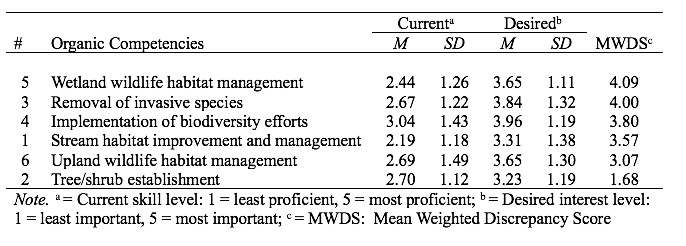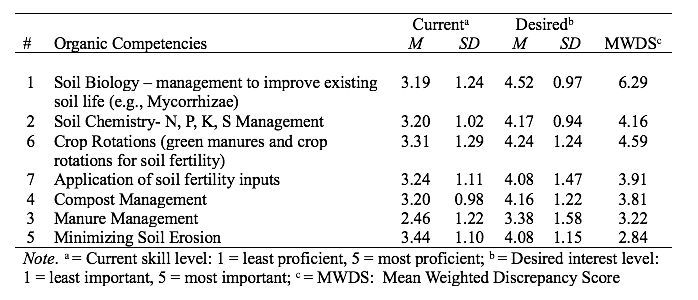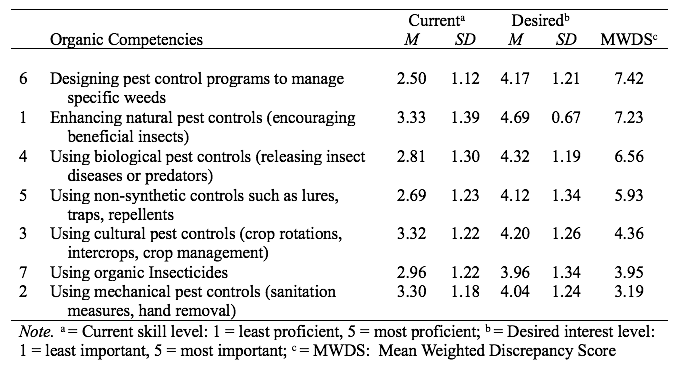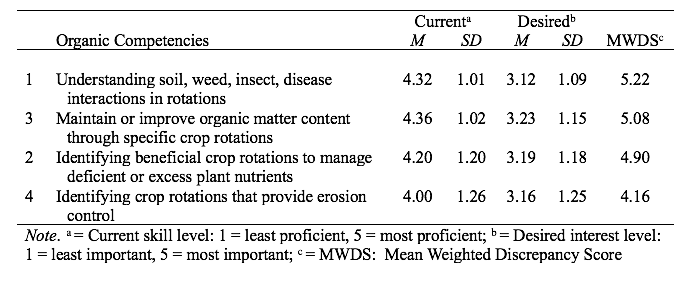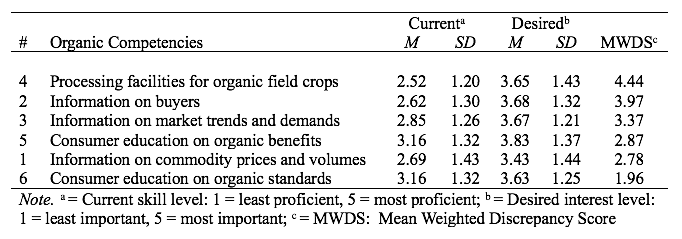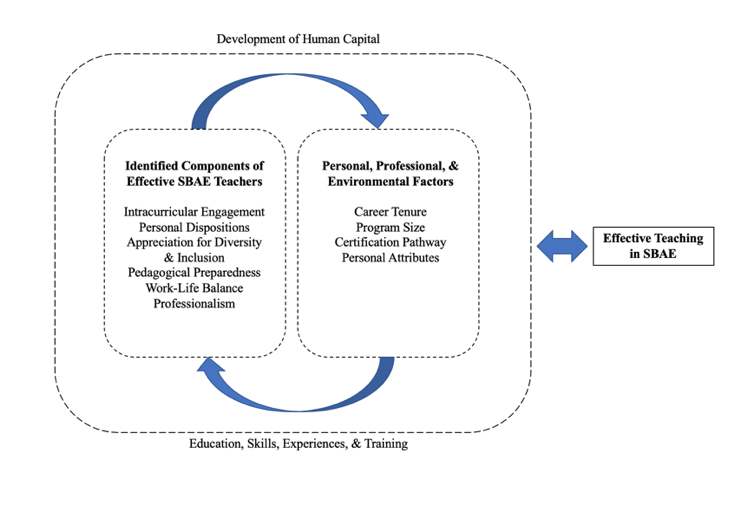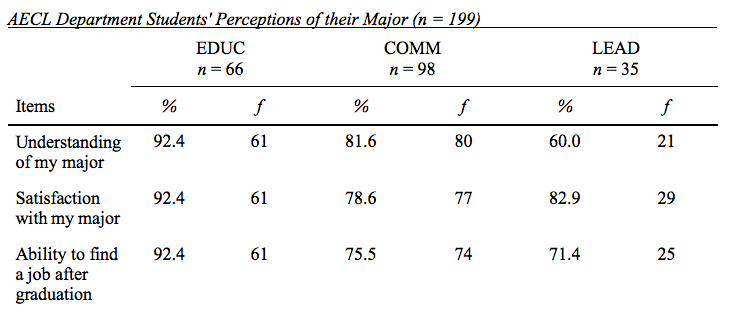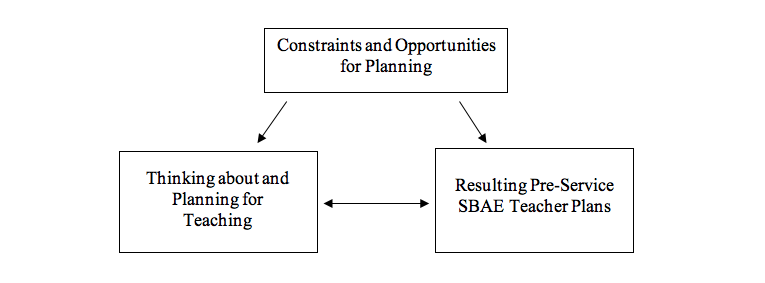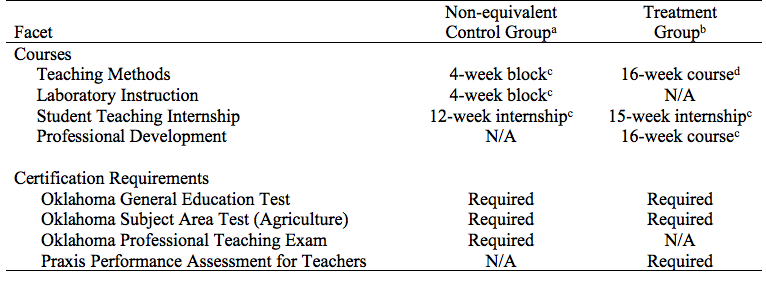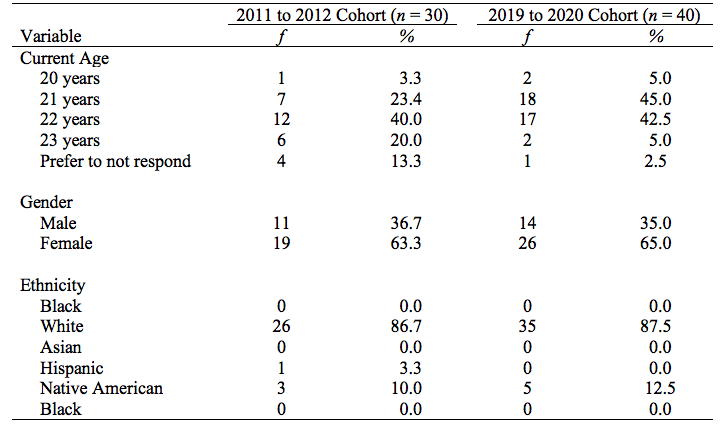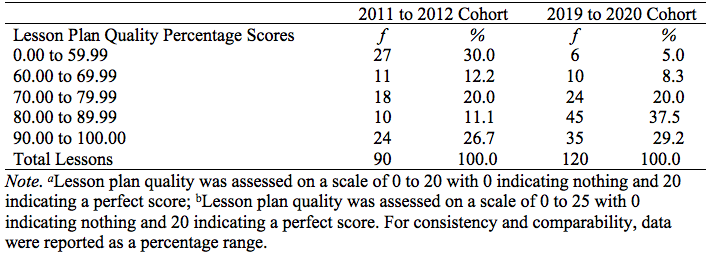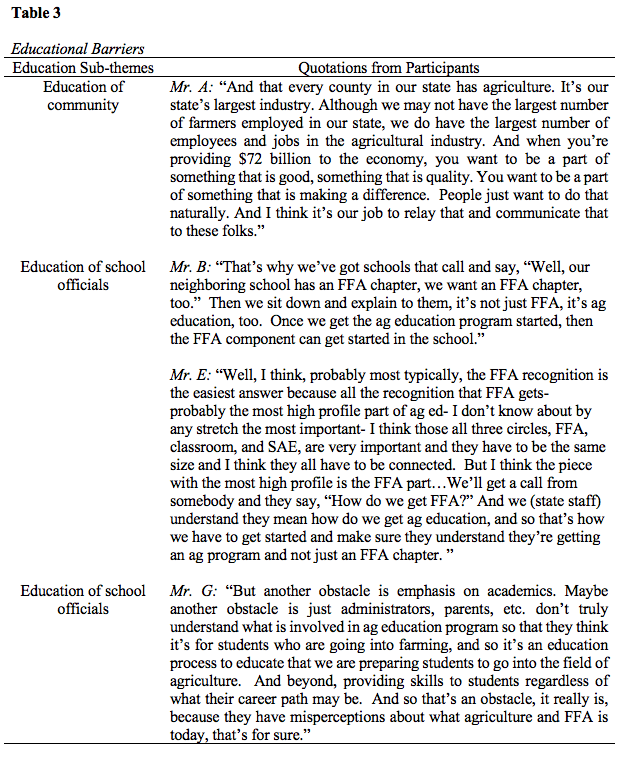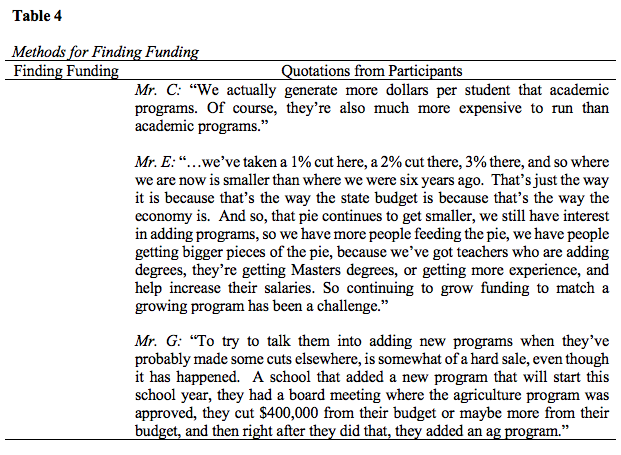Blake C. Colclasure, Doane University, blake.colclasure@doane.edu
Brianna Shanholtzer, STEMscopes, brianna.shanholtzer@gmail.com
Andrew C. Thoron, Abraham Baldwin Agricultural College, andrew.thoron@abac.edu
R. Kirby Barrick, University of Florida, kbarrick@ufl.edu
Abstract
School-based agricultural education (SBAE) has evolved considerably in the last century. This philosophical perspective examines the history of formal agricultural education in the United States and explores how early contributions to agricultural education shaped the structure of modern SBAE. The divergent roles of agricultural education to: 1) provide a qualified agricultural workforce for the 21st century, and 2) educate students about agriculture, are discussed. Furthermore, a conceptual framework for the structure of K-12 agricultural education is proposed, which attempts to provide a solution to gaps in agricultural career readiness and agricultural literacy.
Keywords:agricultural education, agricultural literacy, agriculture workforce, career and technical education
Introduction
The modern agricultural industry in the United States looks far different from the farming operations that provided the country with food, fiber, and natural resources during the early 20th century (Conkin, 2009). Today’s agricultural industry has become more complex and globally interconnected (Ajibola, 2019; Ding & Qian, 2016). Trends in technological advancements have led to increased efficiency and strive to meet demands of a growing global population, while agricultural production has been confronted with social, political, and environmental challenges (National Research Council [NRC], 2009a). The new era of a technological advanced and industrialized agricultural landscape offers solutions to global food shortages, but must continue to take critical steps to be more sustainable and environmentally sensitive (Food and Agriculture Organization [FAO], 2015; FAO, 2017).
The transformational shift in agriculture production has redefined the once blue-collar American farmer. The next generation of agriculturalists require an advanced skillset beyond a general knowledge in agriculture. Twenty-first century “farmers” need to be interdisciplinary problem solvers and critical thinkers who can work collaboratively with diverse groups of people (NRC, 2009a). Furthermore, the new era of agriculture requires workers who are able to apply science and technology to confront challenges that are not yet known (Little, 2019). There has been no other time in history when the requirements of the agricultural worker have been more complex nor the supply of qualified agricultural workers so low (Whittaker & Williams, 2016). The pipeline of qualified agricultural workers appears be corroding and the changing agricultural landscape requires a new definition for the agricultural worker. Consequently, how we prepare the future agricultural workforce may require a new approach (NRC, 2009b).
To add to these challenges, as the agricultural industry battles the shortage of qualified workers (Whittaker & Williams, 2016), the industry is also being confronted with a society that lacks a connection to agriculture (Kover & Ball, 2013). A 2011 national survey conducted by the U.S. Farmers and Ranchers Alliance (USFRA) found that 72% of consumers indicated they know nothing or very little about farming or ranching (2011). A similar national-level survey sent one-year later indicated that more than one in four consumers are confused about the food they purchase and that young adults (i.e., 18- to 29-year-olds) are more confused about food purchases compared to other age groups (USFRA, 2012). However, the survey also revealed that nearly 60% of consumers desire to know more about how food is grown and raised and that lower-income households are particularly likely to say they want to know more but indicate not having the time or money to do so (USFRA, 2012).
Formal and informal educational programs designed to enrich students’ understanding of food and food systems have had a long history in America’s K-12 public education (Salin, 2018). However, these programs have waxed and waned along with shifts in educational theory and funding. Furthermore, socioeconomic gaps in educational opportunities remain. Due to the public’s expanding knowledge gap in agriculture (Kover & Ball, 2013) and growing concern about food production, formal school-based agricultural education (SBAE) needs to be well positioned to teach all students about agriculture in order for them to become informed consumers of agricultural goods and who possess a basic understanding of where food comes from and how it is produced.
Purpose
This philosophical paper explores the role and structure of SBAE in the United States to confront both the need for a modern agricultural workforce and an agriculturally-literate society. The historical development of agricultural education that has led to divergent pathways is discussed: teaching about agriculture and teaching in agriculture. A 21st century model for the structure of SBAE is proposed which attempts to conceptualize agricultural education as a solution to combat two existing gaps: (1) agricultural career readiness; and, (2) agricultural literacy.
Summary of SBAE Structural Development in the United States
The first account of agriculture being formally taught in the United States occurred in Georgia in 1733 when three men were hired to instruct individuals how to produce raw silk (Moore & Gaspard, 1987). Since then, vocational education, and specifically agricultural education, has been evolving. The first major push for vocational education occurred in the early 20th century when the nation’s growing industrial and agricultural societies called for a more practical education beyond liberal arts (Moore & Gaspard, 1987). Hallmark legislative actions, such as the 1862 and 1890 Morrill Acts along with the 1917 Smith-Hughes Act, provided the foundation for formal education in agriculture and mechanical arts across the United States (Barrick, 1989). The passage of the Morrill Act of 1862 supplied each state with funding to establish colleges for higher education in agriculture and mechanical arts, which placed importance on the need for public vocational education in higher education (Moore & Gaspard, 1987).
The 1917 Smith-Hughes Act directly impacted public vocational education at the secondary level by providing federal funding for vocational programs. The Federal Government believed that vocational education was essential to the nation’s welfare and established the act to allow states to develop a system to design and deliver vocational education (Federal Board for Vocational Education, 1917). The resources provided by the Smith-Hughes Act inspired swift changes in secondary vocational education and established state boards of vocational education. The Smith-Hughes Act of 1917 had many rules for the allocation of federal funding. One rule in particular stated that “if a high school student was taught one class by a teacher paid in full or in part from federal vocational funds, that same student could receive no more than fifty percent academic instruction” (Prentice Hall Documents Library, 1998, para 8). As a result, the Federal Vocational Board divided the time of students enrolled in vocational education into three segments, 50 percent in shop work, 25 percent in closely related subjects, and 25 percent in academic course work. The division of student enrollment became known as the 50-25-25 rule (Hayward & Benson, 1993). The Smith-Hughes Act and the 50-25-25 rule guided agricultural education towards a more vocational approach, which emphasized agricultural trade skills and the preparation of students to become farmers (NRC, 1988).
For the next half century, vocational education remained nearly the same. Vocational education emphasized job-specific skills, nearly eliminating theoretical content, and became increasingly segregated by subject matter (e.g., agriculture, industrial arts, home economics). As vocational careers began to evolve with technical changes, students lacked the skills needed in the new workplace and were not effectively trained to adapt to the changing environment. The need for a new paradigm in agricultural education was evident, yet the practice of teaching in SBAE remained stagnant, resulting in declining student enrollment and poor student career preparation.
As a result of declining enrollment in agricultural education in the 1980s, and subsequently a larger population becoming further removed from agriculture, the National Research Council sought to identify a new paradigm for agricultural education programs. The 1988 NRC publication, Understanding Agriculture – New Directions for Education, provided recommendations to broaden the scope of agricultural education as an effort to foster a renewed urgency for a society familiar with the workings of agriculture. In Understanding Agriculture – New Directions for Education, the NRC defined the term agricultural literacy as an “understanding of the food and fiber system [that] includes its history and current economics, social, and environmental significance to all Americans” (NRC, 1988, p. 8). The NRC (1988) claimed that the focus of agricultural education must change, stating that agricultural education is more than vocational agriculture. The NRC also recommended that students should receive education about agricultural from kindergarten through twelfth grade, suggesting the integration of agricultural content into existing core courses. Lastly, the NRC claimed that vocational education in agriculture must be continuously adapting to stay current with the evolving field of agriculture. The new paradigm of SBAE established that agricultural education must be comprehensive in coverage, scientific in method, and practical in impact and focus (NRC, 1988).
Agricultural Education Today
Among the Career and Technical Education (CTE) disciplines established in the United States during the formative years of school-based vocational training, agricultural education has fared considerably well compared to the rest of its counterparts. The number of programs in industrial arts, technology education, and home economics have waned (Lynch, 1996; Volk, 1993) while enrollment in SBAE increased, recruiting an increasingly diverse student population (Brown & Kelsey, 2013; Warner & Washburn, 2009). Like other programs in CTE, SBAE continues to face a shortage of qualified teachers, expressing concern for the sustainability and growth of agricultural education across the country (Boone & Boone, 2009; Eck & Edwards, 2019; Kantrovich, 2010; Moser & McKim, 2020; Myers et al., 2005).
The complete agricultural education program is represented by the three-circle model, consisting of classroom instruction, Supervised Agricultural Experience (SAE), and FFA (Phipps et al., 2008). Each of the three components seen within the model continues to play an integral part of agricultural education across the United States today, despite individual programs reporting varying emphasis on each component (Shoulders & Toland, 2017).
Classroom Instruction
The three-circle model suggests that contextual learning should take place in a laboratory or classroom setting. SBAE has experienced a strong history of experiential learning, stemming from vocational preparation through hands-on and problem-based learning (Parr & Edwards, 2004). Modern instruction in SBAE has become blended in both vocational and academic pursuits. Although active learning strategies have been central to the vision of SBAE, it has been documented that instruction using active learning is currently used far less by teachers than what is recommended (Colclasure et al., 2022; Smith et al., 2015). The emphasis of hands-on learning and skill-based learning in SBAE has provided an opportunity to make science topics applicable and relevant to students, all the while reinforcing academic content (Despain et al., 2016; Phipps et al., 2008). The integration of Science, Technology, Engineering, and Math (STEM) education into agricultural curriculum has become central in modern SBAE (Roberts et al., 2016). Furthermore, the integration of science and math-based learning objectives and learning activities that require higher levels of cognition have shown to increase student learning (Parr et al., 2006; Spindler, 2015).
Student acquisition of content knowledge and skills remain the critical component of education programs. In an era of standard-based testing, measures of student content knowledge are used to provide accountability of student learning. It has been suggested that learning objectives across all disciplines be tied to federal and state learning standards and linked to assessment (Darling-Hammond & Bransford, 2005). For modern SBAE, The National Council for Agricultural Education (NCAE, 2015) developed national learning standards for agricultural education, promoting eight educational pathways that include: (1) Agribusiness Systems; (2) Animal Systems; (3) Biotechnology Systems; (4) Environmental Service Systems; (5) Food Products and Processing; (6) Natural Resource Systems; (7) Plant Systems; and (8) Power, Structural and Technical Systems (The Council, 2015). Many states have also created their own agricultural learning standards and have developed industry certifications for students completing course pathways and passing industry certification exams (Florida Department of Education, 2022; Street et al., 2021). The goal of industry certification is to produce highly qualified graduates who are career ready for specific entry-level positions. Industry certifications have established a more concrete link between industry needs and the content that is taught in some SBAE programs.
SAE
The SAE provides students planned, sequential agricultural instruction that applies classroom topics to student-invested applications that students can understand (Phipps et al., 2008). Through the completion of an SAE, students can gain knowledge in workplace skills, explore different careers in the agricultural industry, and conduct projects that make learning meaningful, inspiring future learning. Despite positive outcomes of the SAE component, many SBAE programs fall short in successfully incorporating SAE programs, which creates a clear deviation from the three-circle model (Lewis et al., 2012a).
Unfortunately, a continuous trend in declining levels of SAE participation has been documented (Lewis et al., 2012b). Despite declining trends in the use of SAE, teachers have generally supported the concept of SAE programs (Osborne, 1988; Retallick, 2010). According to Retallick (2010), the most emergent cause of low student SAE enrollment is teacher difficulty in implementing SAE programs. This phenomenon is not new. Foster (1986) identified factors associated with why SAE programs are not implemented that include: lack of teacher time; lack of facilities (e.g. land labs); lack of student desire; and student demands from other school activities. Adding to these factors, student demographics in SBAE have changed considerably, causing perceived opportunities for quality SAEs to decline (Phipps et al., 2008). A lack of comprehensive preservice teacher training in SAE implementation may also contribute to declining SAEs. In a study on perceived teacher self-efficacy, Wolf (2011) found that novice teachers had lower self-efficacy scores for SAE domains compared to domains for both classroom instruction and FFA. Rubenstein et al. (2016), found that engaged teachers were a primary indicator of students developing and implementing successful SAE programs. Programs that fully embrace the SAE as part of the three-circle model typically require every student to conduct an SAE (Rubenstein & Thoron, 2015) and have strong administrative support (Rayfield & Wilson, 2009).
FFA
The remaining component of the three-circle model is student participation in FFA. FFA provides students with opportunities for personal growth, career exploration, and leadership at local, state, and national levels. Recent FFA membership has become more diverse, consisting of student membership from all 50 states, Puerto Rico, and the U.S. Virgin Islands, which account for a record number of over 850,000 student members (National FFA Organization, 2022). FFA members are provided with opportunities to apply what they have learned in the classroom through competitions that mimic real-world agricultural and career skills. FFA provides students these opportunities through Career Development Events (CDEs). CDEs not only test students’ knowledge about agriculture but also provide students with opportunities to showcase their experience and skills in agriculture (Lundry et al., 2015).
K-8 Agricultural Education
While a foundational level or introductory agriculture course promoting agricultural literacy continues to be a staple in most secondary SBAE programs, middle school agricultural education programs have emerged in some states throughout the country. Although the purpose of SBAE at the middle school level continues to be refined, some states have created guides for middle school agricultural education programs that include basic agricultural literacy and opportunities for students’ agricultural career exploration (Odubanjo, 2018). Further efforts to promote agricultural literacy in public education is evident. In 1981, the USDA established the Agriculture in the Classroom campaign, creating educational programs for K-12 students across the country to learn about agriculture. The Agriculture in the Classroom campaign established agricultural learning standards for K-12 public education that range from basic agricultural knowledge to specific knowledge of the agricultural industry (Spielmaker & Leising, 2013). The Agriculture in the Classroom campaign continues to promote agricultural literacy for K-12 students today.
Preparing an Agriculturally-Literate Society: Teaching “About” Agriculture
The cohesive design and delivery of SBAE across the country has become splintered by varying ideologies of the purpose of agricultural education. The creation of national and state learning standards and industry certification programs that are linked to career-specific pathways have attempted to re-align SBAE to vocational approaches of education. Concurrently, SBAE has seen a large push for increased agricultural literacy and curriculum integration (e.g., STEM) in the last decade, further expanding the mission of agricultural education beyond career readiness. The purpose of agricultural education seems to be split between preparing an agriculturally-literate society and preparing students for careers in agriculture.
The importance of agricultural literacy has been well-noted in the literature. Pope (1990) expressed that agricultural literacy is fundamental to a society that lacks direct connection to production agriculture, so that well informed individuals can make educated decision regarding agriculture. Igo and Frick (1999) claimed that an agriculturally-literate society is needed if the agricultural industry in the United States is to remain successful. Furthermore, Kovar and Ball (2013) suggested that agricultural literacy is imperative to maintain a sustainable and viable agricultural system that is capable to feed a growing global population.
Preparing a Workforce in Modern Agriculture: Teaching “In” Agriculture
CTE has provided a necessary link between workforce readiness, commercial industry, and public education (McNamara, 2009). SBAE, as part of the umbrella of CTE programming, has had an early history rooted within the sole purpose of preparing students for vocational careers within production agriculture (NRC, 1988). Curricula within vocational programs were designed to meet the needs of industry-related employers. From the 1920s to the mid-1980s, curriculum within SBAE was designed with the purpose to train students to become farmers (NRC, 1988). As production agriculture changed over time, SBAE curricula partially developed to reflect such changes, teaching industrial methods of technical agriculture.
Despite efforts across CTE programs to establish a career-ready workforce, a recent trend indicating deficiencies of the number of graduating students who have the knowledge and skills required by industry has led to a nation-wide skills gap (Whittaker & Williams, 2016). Evidence of the skills gap has sparked a recent return to the investment of CTE programs in the United States (Stringfield & Stone, 2017). Governing agencies within CTE have promoted the use of career pathways and industry certifications within secondary education to advance students’ acquisition of skills and successful transition from high school into the workplace (Stringfield & Stone, 2017). In an analysis of U.S. job growth after the Great Recession of 2008, Carnevale et al. (2013) found that the new jobs created after the recession look far different than the jobs that were lost.
Implications for School-based Agricultural Education
The question if agricultural education curricula should be focused in or about agriculture has been debated over the last several decades. Proponents who support either side of the debate have identified valid arguments and have advocated for the advancement of agricultural educational to align with their belief of the purpose of agricultural education. It is hard to disagree with the notion that agricultural education should provide students with a foundational understanding of the production of food, fiber, and natural resources. Increasing the agricultural literacy of our society has never been of greater importance, as today’s youth have become more disconnected from the farm (USDA, 2014; Vallera & Bodzin, 2016). However, if the primary goal of agricultural education lies within improving students’ agricultural literacy, we must question if we are drifting too far from the historical roots of agricultural education, where the initial purpose was to prepare the next generation of agricultural workers. If SBAE becomes too centered in teaching about agriculture, we must ask ourselves if we are still considered a member of the CTE community.
Furthermore, focusing on anything less than preparing students for careers could contribute to an increasing skills gap in the United States. There is clearly a need for agricultural education to be positioned to teach about agriculture and to teach in agriculture. In order to achieve both of these tasks, the structure of agricultural education must be critically examined and evaluated, and alternative structures of agricultural education should be considered. As can be seen in figure one, a conceptual framework is proposed that illustrates an example structure for K-12 public education that allows for the effective delivery of agricultural education programs to teach students about and in agriculture.
The conceptual framework illustrates that teaching about agriculture should occur in grades K-9, with agricultural curriculum integration into core curriculum high school courses. Once students obtain a basic understanding of agricultural concepts they can elect to enter a pathway for career readiness identified by state boards of curriculum and individual schools.
Figure 1
A conceptual framework for teaching “in” and “about” agriculture in K-12 education.

Kindergarten – 5th Grade
The first stage in a holistic effort to improve the agricultural literacy among the public is to teach agricultural topics in grades K-5. The importance of agricultural education programs in grades K-5 should not be undervalued, as this formative stage of cognitive development is central to establish a life-long appreciation and interest in agriculture. Programs such as the Agriculture in the Classroom campaign should continue to strive to make sure that every child is exposed to educational applications that engages them in agricultural topics. Opportunities for children to be exposed to agriculture should extend beyond the classroom, increasing the exposure of children to school gardens and working farms. Every child should know where food comes from at the most basic level, and public education at lower levels and in every community should be the primary mechanism to ensure this occurs.
6th Grade – 8th Grade
Federal and state efforts requiring a basic agricultural education course in public education is well-warranted. This framework proposes that students in grades sixth through eighth should be required to enroll in at least one agricultural education course. Courses at this level should focus on teaching students about agriculture on a foundational level. Coursework should be oriented toward agricultural literacy, consisting of subject matter that is rich in consumer knowledge that explores food production from field to fork. Ideally, students will take more than one agricultural education course at the middle school level. However, the teacher shortage in agricultural education (Camp et al., 2002; Kantrovich, 2010; Roberts & Dyer, 2004), and the current status of agricultural education, which is focused at the high school level, creates difficulties in providing agricultural education to every middle school student. Innovative solutions, such as additional middle school agricultural endorsement programs for core curriculum teachers, and offering online agriculture courses, could provide every middle school student with at least one agricultural course. Agricultural courses at the middle school level should focus on basic agricultural content knowledge and literacy.
9th Grade
This framework also proposes that every student should take an advanced introduction to agriculture course during their first year of high school. This course will expand upon the required middle school agriculture course by exposing students to complex agricultural issues that emphasize students’ use of higher order thinking. However, the focus of the advanced introduction to agriculture course will still be centered in teaching about agriculture and will allow students to explore agricultural careers.
9th-12th Grade
Contrary to the integration of core subjects into agriculture courses, this framework highlights the need to integrate agricultural topics into core classes. It is believed that this method will expand agricultural literacy for students who elect to not go into agricultural career pathways. Furthermore, the integration of real-life applications is needed in core curriculum. Stakeholders of agriculture and key organizations in agricultural education should design lessons that have an agricultural context for core curriculum classes that teachers can use to supplement their current lessons.
10th-12th Grade
In order to prepare a specialized and highly-qualified agricultural workforce for the 21st century, this framework proposes that programs should strategically implement a series of career pathway courses that are uniquely tailored to the occupational needs of each state. Such courses should be designed to allow students to obtain the skills needed in localized agricultural careers. The implementation of career certifications in SBAE, which are currently found in some states, provide a necessary link between industry and education. Furthermore, the design of career preparation courses should expand beyond the immediate skill sets needed in the industry and should promote students’ social, critical thinking, problem solving, and communication skills that are needed in the 21st century workforce.
Conclusion
The development of agricultural education was first established to prepare individuals for the skills they needed to work on a farm. Following the industrial revolution, federal acts expanded vocational education in secondary schools and post-secondary institutions. The focus in trade-based learning was evident in agricultural education until the reinvention of agricultural education during the 1990s. Agricultural education expanded its mission to teach beyond agricultural trades, emphasizing agricultural knowledge, as opposed to specific career skills. The new paradigm of agricultural education may have been essential for the growth of SBAE. However, the purpose of SBAE to teach about agriculture has led to deficiencies in students’ career preparation while also not fully reaching its potential to educate society about agriculture.
The conceptual framework provided in this paper was developed to offer a solution for agricultural education to be better positioned to teach both about and in agriculture. The framework expands upon existing efforts for agricultural education to reach K-8 students. An expansion of agricultural education at the middle school level is necessary to fully expose students about agriculture. An additional course at the 9th grade level, which exposes students to higher level thinking about agriculture, is necessary. These courses along with the integration of agricultural contexts into core curriculum will aim to decrease the public’s knowledge gap of agriculture. Courses beyond an advanced introductory course will focus on specific agricultural careers and will exist for the purpose of providing students with the advanced skills they need in specific agricultural industries. The authors of the proposed framework understand the complexities associated with the redevelopment of the structure of agricultural education programs; however, in order for agricultural education to simultaneously provide solutions to both career readiness and agricultural literacy, the structure and purpose of agricultural education at each level should be discussed and refined on a national level.
The implementation of the provided conceptual framework would have dramatic implications for SBAE. An enormous increase in the number of students enrolled in SBAE courses would be seen. The expansion of middle school agricultural education programs would educate all students about agriculture, putting less pressure for high school agriculture courses to teach both about and in agriculture. Furthermore, it would be expected that agricultural literacy would increase in society, resulting in a new generation that appreciates and understands the basic components of food production. A renewed focus on advanced career preparation for specific career pathways could potentially reduce the number of students being taught career-specific agricultural skills. However, students completing specific career pathways that are tailored to the demands of industry, would be adequately prepared to enter the workforce or continue advanced, postsecondary training in a specific field. The investment in this educational design could contribute to closing the large skills gap identified in industry. Agricultural education has advanced in many ways to become a model for CTE. Despite its many successes over the last century, the current structure of agricultural education is beginning to experience unintended strain from pressures asking agricultural education to do too much with its existing structure. The current structure of SBAE is not appropriately designed to teach both about and in agriculture, where both purposes are given the attention they need. The proposed conceptual framework included in this paper is one of many potential designs to offer alternatives for the structure of agricultural education to meet challenges that are currently being faced in agriculture.
References
Ajibola, O. R. (2019). Trend of globalization and its impact on agriculture: Forestry share. International Journal of Agriculture, Forestry, and Fisheries, 7(1), 5-11. http://www.openscienceonline.com/journal/archive2?journalId=706&paperId=5284
Barrick, R. K. (1989). Agricultural education: Building upon our roots. Journal of Agricultural Education, 30(4), 24-29. https://doi.org/10.5032/jae.1989.04024
Boone, H. N., & Boone, D. A. (2009). An assessment of problems faced by high school agricultural education teachers. Journal of Agricultural Education, 50(1), 21-32. https://doi.org/10.5032/jae.2009.01021
Brown, N. R., & Kelsey, K. D. (2013). Sidewalks and city streets: A model for vibrant agricultural education in urban American communities. Journal of Agricultural Education, 54(2), 57-69. https://doi.org/10.5032/jae.2013.02057
Camp, W. G., Broyles, T., & Skelton, N. S. (2002). A national study of the supply and demand for teachers of agricultural education in 1991-2001. Virginia Tech, College of Agriculture and Life Science.
Carnevale, A. P., Smith, N., & Strohl. J. (2013). Recovery: Job growth and education requirements through 2020. Georgetown University Center on Education and the Workforce. https://cew.georgetown.edu/cew-reports/recovery-job-growth-and-education-requirements-through-2020/
Colclasure, B. C., Thoron, A. C., & Dempsey, J. (2022). Factors relating to agriculture teachers’ perceived use of instructional methods. Advancements in Agricultural Development, 3(4), 1-16. https://doi.org/10.37433/aad.v3i4.235
Conkin, P. (2009). A revolution down on the farm: The transformation of American agriculture since 1929. University Press of Kentucky.
Darling-Hammond, L. & Bransford, J. (2005). Preparing teachers for a changing world: What teachers should learn and be able to do. Jossey-Bass.
Despain, D., North, T., Warnick, B. K., & Baggaley, J. (2016). Biology in the agriculture classroom: A descriptive comparative study. Journal of Agricultural Education, 57(1), 194-210. https://doi.org/10.5032/jae.2016.01194
Ding, X., & Qian, Y. (2016). Globalization, employment and agriculture: A review of the eleventh forum of the world association for political economy. World Review of Political Economy, 7(4), 541-555. https://doi.org/10.13169/worlrevipoliecon.7.4.0541
Eck, C. J., & Edwards, M. C. (2019). Teacher shortage in school-based, agricultural education (SBAE): A historical review. Journal of Agricultural Education, 60(4), 223-239. https://doi.org/10.5032/jae.2019.04223
Federal Board of Vocational Education (1917). Statement of policies. (Bulletin No. 1). Government Printing Office.
Florida Department of Education (2022). Curriculum frameworks. https://www.fldoe.org/academics/career-adult-edu/career-tech-edu/curriculum-frameworks/2022-23-frameworks/agriculture-food-natural-resources.stml
Food and Agriculture Organization of the United Nations. (2015). The state of food insecurity in the world. http://www.fao.org/3/a-i4646e.pdf
Food and Agriculture Organization of the United Nations. (2017). The future of food and agriculture: Trends and challenges. http://www.fao.org/3/a-i6583e.pdf
Foster, R. M. (1986). Factors limiting vocational agriculture student participation in supervised occupational experience programs in Nebraska. Journal of the American Association of Teacher Educators in Agriculture, 27(4), 45-50.
Hayward, G. C., & Benson, C. S. (1993). Vocational-technical education: Major reforms and debates 1917-present. United States Department of Education Office of Vocational and Adult Education 1993 Report. https://files.eric.ed.gov/fulltext/ED369959.pdf
Igo, C., & Frick, M. (1999). A case study assessment of standard benchmarks for implementing food and fiber systems literacy. Proceedings of the 18th Annual Western Region Agricultural Education Research Meeting. Corpus Christi, TX.
Kantrovich, A. J. (2010). The 36th volume of a national study of the supply and demand for teachers of agricultural education from 2006-2009. American Association of Agricultural Educators, Michigan State University.
Kovar, K. A., & Ball, A. L. (2013). Two decades of agricultural literacy research: A synthesis of the literature. Journal of Agricultural Education, 54(1), 167-178. https://doi.org/10.5032/jae.2013.01167
Lewis, L. J., Rayfield, J., & Moore, L. L. (2012a). An assessment of students’ perceptions toward factors influencing supervised agricultural experience participation. Journal of Agricultural Education, 53(4), 55-69. https://doi.org/10.5032/jae.2012.04055
Lewis, L. J., Rayfield, J., & Moore, L. L. (2012b). Supervised agricultural experience: An examination of student knowledge and participation. Journal of Agricultural Education, 53(4), 70-84. https://doi.org/10.5032/jae.2012.04070
Little, A. (2019). The fate of food: What we’ll eat in a bigger, hotter, smarter world. Penguin Random House, LLC
Lynch, R. L. (1996). In search of vocational and technical teacher education. Journal of Career and Technical Education, 13(1), 5-16. https://doi.org/10.21061/jcte.v13i1.508
Lundry, J., Ramsey, J. W., Edwards, M. C., & Robinson, S. (2015). Benefits of career development events as perceived by school-based, agricultural education teachers. Journal of Agricultural Education, 56(1), 43-57. https://doi.org/10.5032/jae.2015.01043
McNamara, B. R. (2009). The skill gap: Will the future workplace become an abyss. Techniques: Connecting Education and Careers, 84(5), 24-27. https://eric.ed.gov/?id=EJ840446
Moore, G. E., & Gaspard, C. (1987). The quadrumvirate of vocational education. Journal of Technical Education, 4(1).
Moser, E. M., & McKim, A. J. (2020). Teacher retention: A relational perspective. Journal of Agricultural Education, 61(2), 263-275. https://doi.org/10.5032/jae.2020.02263
Myers, B. E., Dyer, J. E., & Washburn, S. G. (2005). Problems facing beginning agriculture teachers. Journal of Agricultural Education, 46(3), 47-55. https://doi.org/10.5032/jae.2005.03047
National Council for Agricultural Education (NCAE). (2015). Agriculture, Food and Natural Resources (AFNR) Career Cluster Content Standards, 1-142. https://thecouncil.ffa.org/afnr/
National FFA Organization. (2015). Our membership. https://www.ffa.org/our-membership/
National Research Council. (1988). Understanding agriculture: New directions for education. The National Academies Press.
National Research Council. (2009a). A new biology for the 21 century. The National Academies Press.
National Research Council. (2009b). Transforming agricultural education for a changing world. The National Academies Press. https://doi.org/10.17226/12602
Odubanjo, A. (2018). Perceptions of middle, high school and community college agricultural teachers in Iowa regarding agricultural awareness concepts and activities in the middle school curriculum: Grades 7-9 [Dissertation, Iowa State University]. Iowa State University Digital Repository. https://lib.dr.iastate.edu/cgi/viewcontent.cgi?article=7435&context=etd
Osborne, E. W. (1988). Planning and supervision strategies for SOE programs in agriculture. Journal of American Association of Teacher Educators in Agriculture, 29(4), 49-56.
Parr, B. A., & Edwards, M. C. (2004). Inquiry-based instruction in secondary agricultural education: Problem-solving – an old friend revisited. Journal of Agricultural Education, 45(4), 106-117. https://doi.org/10.5032/jae.2004.04106
Parr, B. A., Edwards, M. C., & Leising, J. G. (2006). Effects of a math-enhanced curriculum and instructional approach on the mathematics achievement of agricultural power and technology students: An experimental study. Journal of Agricultural Education, 47(3), 81-93. https://doi.org/10.5032/jae.2006.03081
Phipps, L. J., Osborne, E. W., Dyer, J. E., & Ball, A. (2008). Handbook of agricultural education in public schools (6th ed.). Thomson Delmar Learning.
Pope, J. (1990). Agricultural literacy: A basic American need: The Agricultural Education Magazine, 62(9), 8.
Prentice Hall Documents Library (1998). Smith-Hughes Act of 1917. https://wps.prenhall.com/wps/media/objects/434/445252/DocumentsLibrary/docs/smith917.htm
Rayfield, J., & Wilson, E. (2009). Exploring principals’ perceptions of supervised agricultural experience. Journal of Agricultural Education, 50(1) 70-80. https://doi.org/10.5032/jae.2009.01070
Retallick, M. S. (2010). Implementation of supervised agricultural experience programs: The agriculture teachers’ perspective. Journal of Agricultural Education, 51(4), 59-70. https://doi.org/10.5032/jae.2010.04059
Roberts, T. G., & Dyer, J. E. (2004). Inservice needs of traditionally and alternatively certified agriculture teachers. Journal of Agricultural Education, 45(4), 57-70. https://doi.org/10.5032/jae.2004.04057
Roberts, T. G., Harder, A., & Brashears, M. T. (eds.) (2016). American Association for Agricultural Education national research agenda: 2016-2020. Gainesville, FL: Department of Agricultural Education and Communication.
Rubenstein, E. D., & Thoron, A. C. (2015). Supervised agricultural experience programs: An examination of committed teachers and student-centered programs. Journal of Agricultural Education, 56(4), 75-89. https://doi.org/10.5032/jae.2015.04075
Rubenstein, E. D., Thoron, A. C., Colclasure, B. C., & Gordon, J. A. (2016). Supervised agricultural experience programs: An examination of the development and implementation of urban programs. Journal of Agricultural Education, 57(4), 218-234. https://doi.org/10.5032/jae.2016.04217
Salin, S. (2018). The sustained impacts of an agriculture-based youth development program on alumni’s connection to the environment, food, community and self [Master’s thesis, The Evergreen State College]. The Evergreen State College Archives. https://archives.evergreen.edu/masterstheses/Accession86-10MES/Salin_Thesis_2018.pdf
Shoulders, C. W., & Toland, H. (2017). Millennial and non-millennial agriculture teachers’ current and ideal emphasis on the three components of the agricultural education program. Journal of Agricultural Education, 58(1), 85-101. https://doi.org/10.5032/jae.2017.01085
Smith, K. L., Rayfield, J., & McKim, B. R. (2015). Effective practices in STEM integration: Describing teacher perceptions and instructional method use. Journal of Agricultural Education, 56(4), 182-201. https://doi.org/10.5032/jae.2015.04183
Spielmaker, D. M., & Leising, J. G. (2013). National agricultural literacy outcomes. Utah State University, School of Applied Sciences & Technology. Logan, UT. http://agclassroom.org/teacher/matrix
Spindler, M. (2015). Science integrating learning objectives: A cooperative learning group process. Journal of Agricultural Education, 56(1), 203-220. https://doi.org/10.5032/jae.2015.01203
Street, A., Stripling, C., Ricketts, J., Conner, N., & Boyer, C. (2021). Identifying Tennessee school-based agricultural education student growth and program accountability metrics. Advancements in Agricultural Development, 2(2), 86-96. https://doi.org/10.37433/aad.v2i2.91
Stringfield, S., & Stone, J. R. (2017). The labor market imperative for CTE: Changes and challenges for the 21st century. Peabody Journal of Education, 92(2), 166-179. https://doi.org/10.1080/0161956X.2017.1302209
United States Department of Agriculture. (2014). Census highlights: Farm demographics. https://www.nass.usda.gov/Publications/Highlights/2014/Farm_Demographics/index.php
United States Farmers and Ranchers Alliance. (2011). Nationwide surveys reveal disconnect between Americans and their food. Cision PR Newswire. https://www.prnewswire.com/news-releases/nationwide-surveys-reveal-disconnect-between-americans-and-their-food-130336143.html
United States Farmers and Ranchers Alliance. (2012). Americans say food production headed in right direction, widespread misperceptions remain. Cision PR Newswire. https://www.prnewswire.com/news-releases/americans-say-food-production-headed-in-right-direction-widespread-misperceptions-remain-179465971.html
Vallera, F. L., & Bodzin, A. M. (2016). Knowledge, skills, or attitudes/beliefs: The context of agricultural literacy in upper-elementary science curricula. Journal of Agricultural Education, 57(4), 101-117. https://doi.org/10.5032/jae.2016.04101
Volk, K. S. (1993). Enrollment trends in industrial arts/technology teacher education from 1970-1990. Journal of Technology Education, 4(2), 46-59. https://doi.org/10.21061/jte.v4i2.a.4
Warner, W. J., & Washburn, S. G. (2009). Issues facing urban agriscience teachers: A Delphi study. Journal of Agricultural Education, 50(1), 105-115. https://doi.org/10.5032/jae.2009.01105
Wittaker, J. G., & Williams, G. (2016). Skills gap – a strategy for increasing knowledge worker supply and demand. Journal of Business, 1(4), 13-24. https://doi.org/10.18533/job.v1i4.42
Wolf, K. J. (2011). Agricultural education perceived teacher self-efficacy: A descriptive study of beginning agricultural education teachers. Journal of Agricultural Education, 52(2), 163-176. https://doi.org/10.5032/jae.2011.02163


